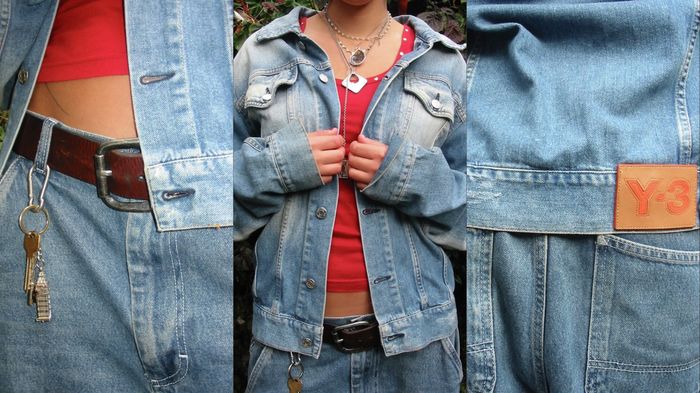BRAT fashion: A post mortem
Rebecca Raybould disects the legacy of BRAT girl summer

“Really hot but in a scary way.” “Known but at the same time unknowable.” “Definitely a je ne sais quoi situation.” This was how the hot internet girl of 2024 was described in the opening of Charli XCX’s 360 music video. Among these hot girls were the likes of Julia Fox, Chloe Cherry and Gabriette. Their styles are the antithesis of the ‘clean girl’ aesthetic that has dominated the 2020s so far. If the clean girl’s wardrobe of white linen, dainty necklaces and slicked back buns reflect an idealised lifestyle of productivity, wealth, and health, then the BRAT encapsulates ideals of decadence, impulsivity and rawness.
“Recession-pop is back with its escapist tendencies and dance beats (think Kesha post-2008)”
However, this shift in fashion has been led by an equally significant shift in music. Triggered by the cost-of-living crisis, and economic downturns across the world, recession-pop is back with its escapist tendencies and dance beats (think Kesha post-2008). The same can be said of the world of fashion. In the midst of the cost of living crisis, a lifestyle signified through the accumulation of consumer goods has not just fallen out of favour, it has become distasteful. When the ‘clean girl’ influencer pulls out a Rhode lip tint from her bag, or dons herself in the Olsen twins luxury staple ‘The Row’, her audience senses the ever-widening economic chasm between them. While this content has always been aspirational, at a time when increasing numbers of people are facing financial hardship, this unattainable consumerism only serves to isolate their audience.
“The Brat may still be aspirational, but she is not isolating.”
BRAT has not just brought back the sounds of post-recession pop, it has also brought back its signature fashion, albeit with a contemporary twist. The fashion of the early 2010s bares a resemblance to its modern iteration: not least black micro-skirts, heavy accessorization and lived-in makeup. Even the icons of the 2014 style are making a comeback, with grainy photos of Alexa Chung and tumblr-darling Sky Ferreira gracing Pinterest and TikTok. While the style isn’t exactly the same, it signals a return to a more nonchalant approach to fashion. The Brat may still be aspirational, but she is not isolating. There are no must-have purchases to ‘get the look’, beyond perhaps a pouch of tobacco, and a worn in white tank. Instead the style signifiers are generic items which can be easily purchased from charity shops or affordably on the high street. Companies such as H&M have tried to capitalise on this popularity: they have failed. When the essence of the aesthetic is indie, corporate attempts to recreate it inevitably fall flat. The style is in the personal curation, rather than the item.
This changing taste has already begun to hit the runways. Alexander McQueen described their most recent collection as embodying a ”rough opulence’’. Its decadent silhouettes are contrasted with more traditionally punk elements, such as studs and leather. Schiaparelli followed a similar trend in their SS24 collection, which featured similarly heavy fabrics, combined with heavy accessorization. Similarly, Dior’s recent collection features indie staples such as plaid and buckles, and a heavy, HEAVY side part. However, the common thread in the collections is the element of juxtaposition, particularly in the contrast between luxurious silhouettes with a grungy styling and design details. Ultimately, this is an excellent example of how to get the look with minimal purchasing; details as small as a hair part or over-accessorization signal a rejection of the almost ubiquitous minimalism of the early 2020s and the consumerism that defined it.
BRAT summer has revealed a craving for greater authenticity and accessibility from trends that have for so long been driven by the opposite. However, this rejection of highly curated images of wellness and simplicity is not perfect. Are we replacing perfect images with equally curated imperfect ones? While smoking a cigarette on the pavement outside a kebab shop feels great, the creation and documentation of these authentic moments, and the fashion associated with them seems to rob it of its joy. While we may no longer have to buy into hyper specific concealers, the nebulous concept of the 365PARTYGIRL’s je ne sais quoi is equally demanding. Are we rejecting the constant demand for flawlessness, or are we just replacing lash serum with clumpy mascara?
 Arts / Plays and playing truant: Stephen Fry’s Cambridge25 April 2025
Arts / Plays and playing truant: Stephen Fry’s Cambridge25 April 2025 News / Candidates clash over Chancellorship25 April 2025
News / Candidates clash over Chancellorship25 April 2025 Music / The pipes are calling: the life of a Cambridge Organ Scholar25 April 2025
Music / The pipes are calling: the life of a Cambridge Organ Scholar25 April 2025 Comment / Cambridge builds up the housing crisis25 April 2025
Comment / Cambridge builds up the housing crisis25 April 2025 News / Cambridge Union to host Charlie Kirk and Katie Price28 April 2025
News / Cambridge Union to host Charlie Kirk and Katie Price28 April 2025





